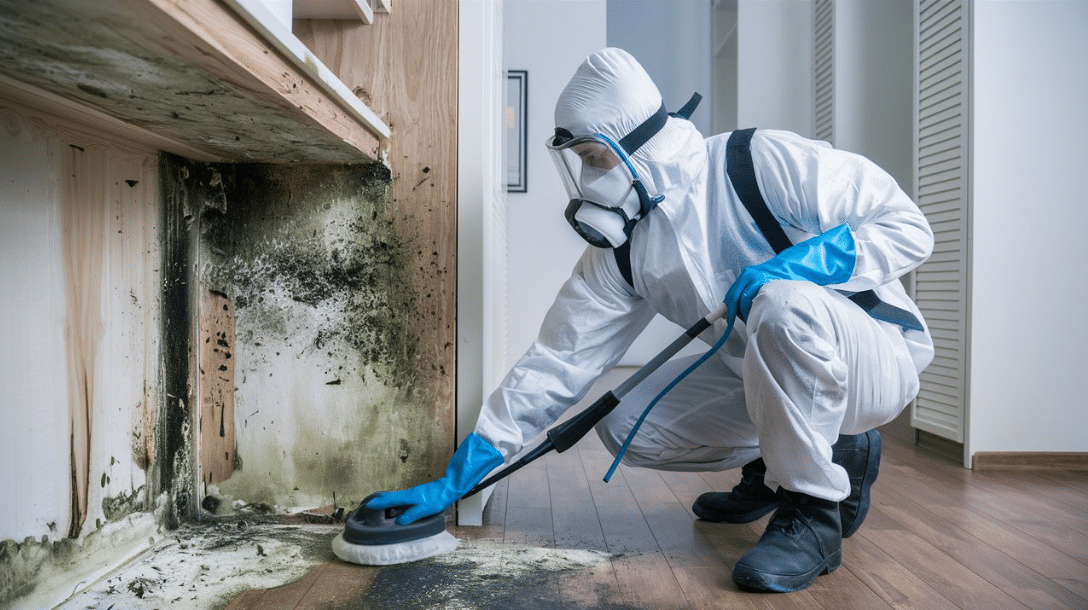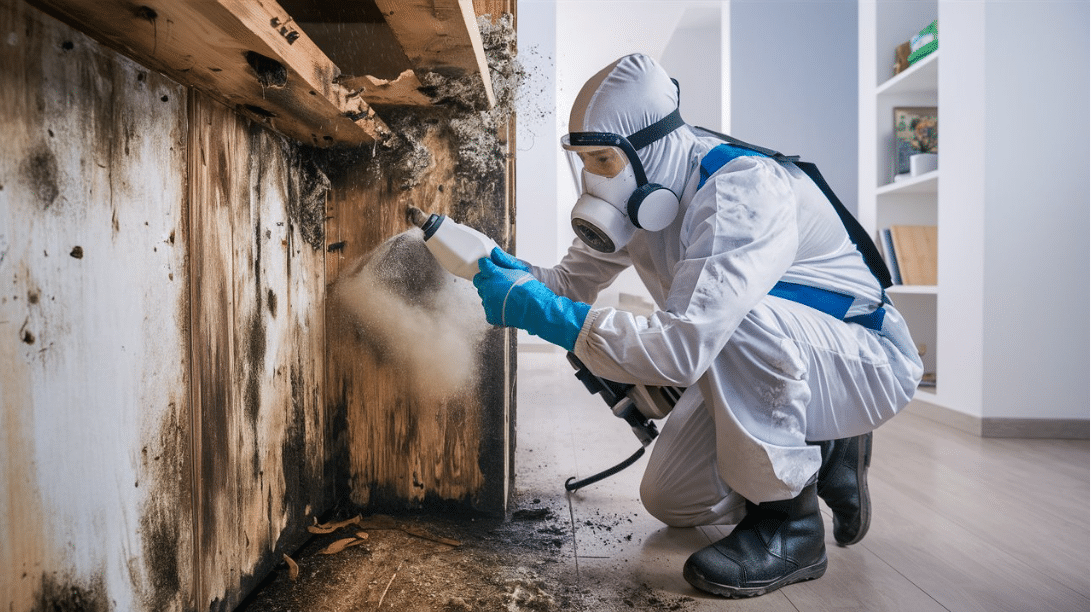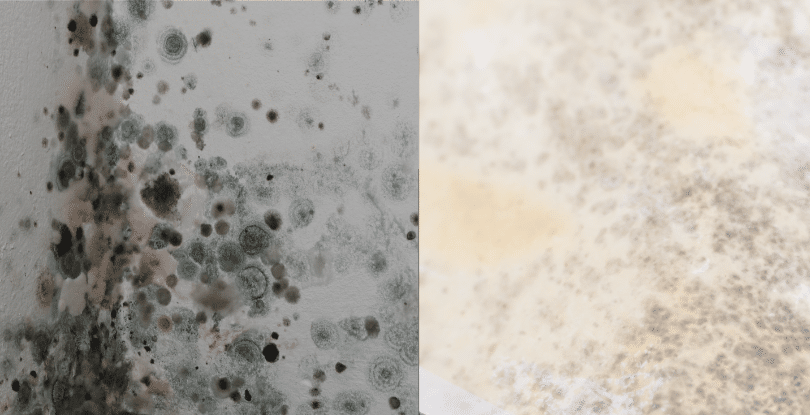What is Mold?
Mold is a type of fungus that grows in damp, warm environments. It can appear as a fuzzy or slimy patch on surfaces. Mold thrives in places with high humidity, moisture, and warmth.Mold starts as tiny spores, which float in the air. When these spores land on a wet surface, they begin to grow. Mold can appear in many colors and textures, and it can cause damage to materials like wood.In nature, mold plays a role in breaking down dead plants and trees. This helps recycle nutrients back into the soil. However, when mold grows indoors, it can be a problem for your home and health.Different Types of Mold Growth on Wood
Here are the most common types of mold growth on wood:1. Black Mold (Stachybotrys Chartarum)
Black mold is a dark greenish-black color. It often looks slimy and may spread in patches on wood surfaces. This mold usually grows in damp areas. Black mold can cause respiratory issues and allergic reactions. It’s important to handle it carefully to avoid health problems.
2. White Mold
White mold appears as a white, powdery substance. It can look fuzzy or velvety and is often found in cool, damp places. While white mold might not be as harmful as black mold, it can still cause respiratory issues and allergies. It can also indicate moisture problems that need to be addressed.
3. Green Mold
Green mold is usually bright green and can look fuzzy or velvety. It tends to grow in areas with high humidity. Green mold can be a sign of excess moisture. It may cause respiratory issues and allergies, especially in people with weakened immune systems.
4. Gray Mold
Gray mold has a dusty, grayish appearance. It often grows in patches on wood surfaces and is commonly found in poorly ventilated areas. Gray mold is less commonly discussed but can still cause health issues similar to other mold types. It’s important to remove it promptly to avoid further problems.

Visual Characteristics of Mold on Wood
Here is how to visually check mold on wood:1. Color Variations
Mold on wood can come in various colors, each indicating a different type of mold. Black mold is often dark green or black and can look slimy. It’s one of the most common and dangerous types of mold. White mold appears as a white or grayish powdery substance. It can sometimes be mistaken for dust. Green mold has a greenish tint and can look fuzzy. This type is often found in damp areas. Gray mold is, as the name suggests, gray and usually has a more fuzzy appearance. Each type of mold has a unique color that can help in identifying it on wood surfaces.2. Texture and Patterns
Mold on wood can have different textures. It may look fuzzy, like a soft layer of cotton. Some molds may appear slimy or wet, especially if there is a lot of moisture. Others might look powdery, almost like a dusting on the wood. The texture can give clues about how severe the mold problem is and how long it has been growing.3. Common Signs and Symptoms
When looking for mold on wood, watch for specific signs:- Stains: Mold can cause dark or discolored spots on the wood.
- Spots: Small, round patches might appear on the surface.
- Surface Changes: The wood might feel rougher, or you may notice swelling and warping. These changes can indicate that mold is growing beneath the surface.
How to Identify Mold on Wood
To identify mold on wood, start by checking areas where moisture is common, like basements or bathrooms. Look closely at wooden surfaces for any of the signs mentioned above. It’s important to inspect not only the surface but also the underside and edges of the wood, as mold can grow in hidden places.Tools and Methods for Detecting Mold
Using tools can help in finding mold that’s not visible to the naked eye:- Moisture Meters: These devices measure the moisture level in wood. High moisture levels can indicate mold growth.
- Visual Inspections: A thorough visual check can help you spot mold growth. Look for discoloration, texture changes, or any of the signs described earlier.
Mold Remediation Professionals vs. DIY Inspection
If you want to prevent mold growth, it’s best to call Mold Remediators USA. They have specialized equipment for mold testing and experience to handle larger infestations safely. For smaller issues, you can start with a DIY inspection to remove the mold. Simple steps include checking for visible signs of mold stains and using a moisture meter to find damp areas. If the problem seems extensive or difficult to manage, seeking professional help is a good choice.Health Risks Associated with Mold on Wood
Mold growth in your home and wood can lead to several health problems. Common issues include:- Allergic Reactions: People might experience sneezing, runny nose, or itchy eyes when exposed to mold.
- Asthma: Mold can trigger asthma attacks or make symptoms worse for those who have asthma.
- Respiratory Problems: Breathing in mold spores can cause coughing, wheezing, and shortness of breath.
- Skin Irritations: Some people may develop rashes or itchiness on their skin from touching moldy surfaces.
Prevention and Removal of Mold on Wood
Preventing mold from growing on wood involves:- Controlling Humidity: Keep indoor humidity below 60% to reduce mold growth. Use dehumidifiers and air conditioners to help control moisture.
- Proper Ventilation: Make sure your home is well-ventilated, especially in areas where moisture is common, like bathrooms and kitchens.
- Fix Water Issues: Quickly address any leaks or water damage to prevent mold from taking hold.
Removal Techniques
For minor mold problems on wood, you can try these DIY steps:- Clean with Soapy Water: Use soap and water to scrub mold off wooden surfaces. Make sure to dry the area thoroughly afterward.
- Use Vinegar: Vinegar can help kill mold. Apply it directly to the affected area and scrub it clean.
- Avoid Bleach: While bleach is often suggested, it might not be as effective on porous materials like wood.




